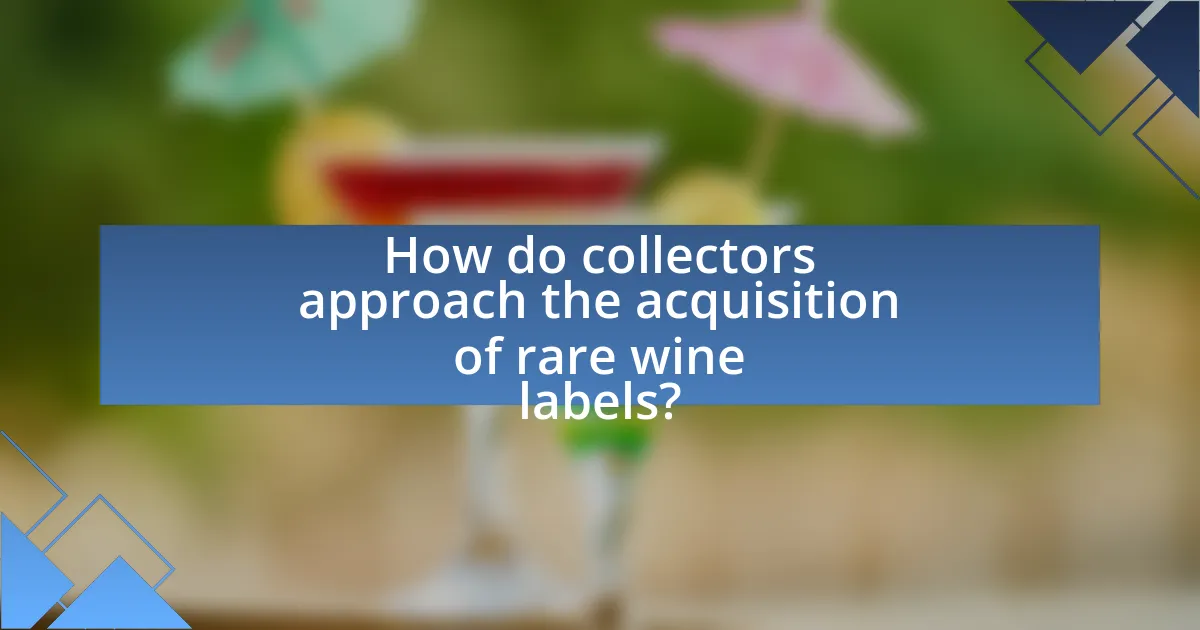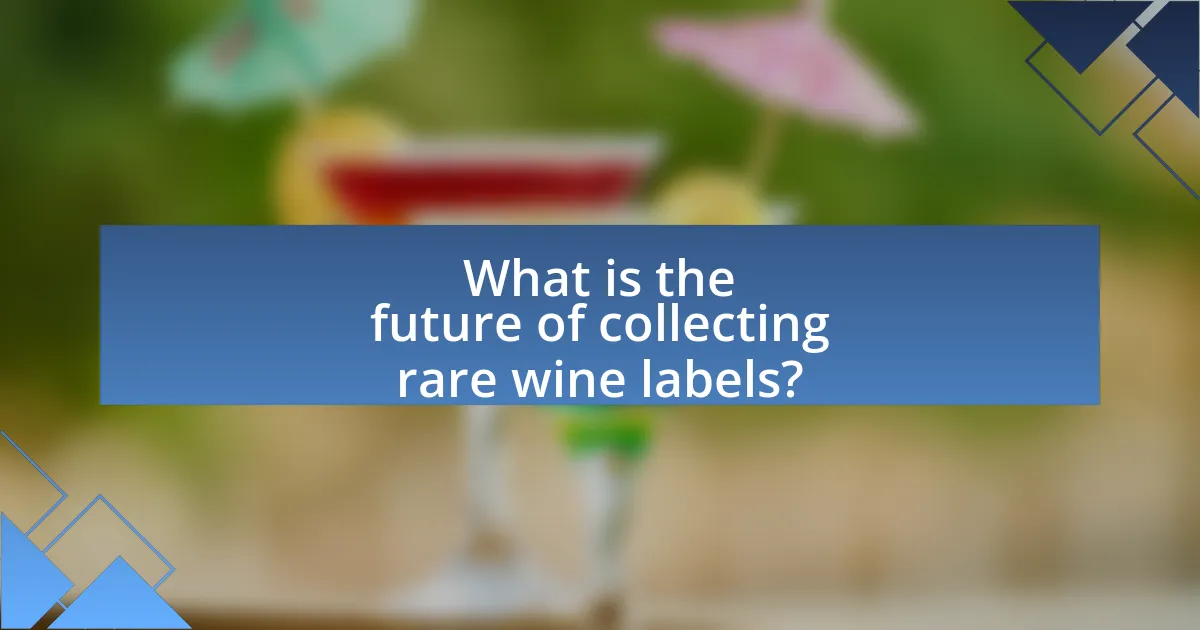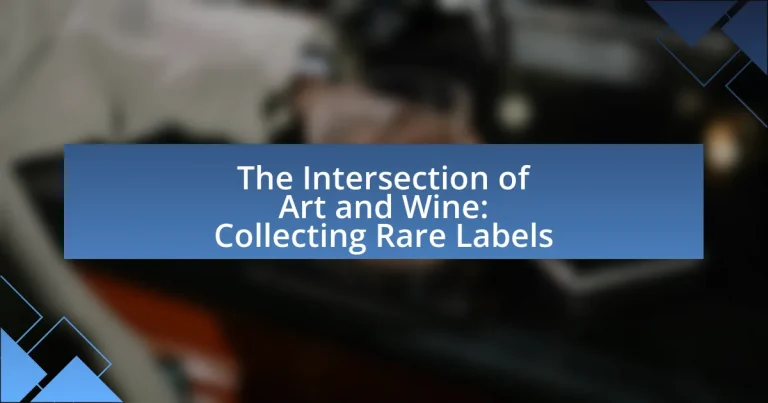The article explores the intersection of art and wine through the lens of collecting rare wine labels, highlighting their aesthetic and cultural significance. It discusses the emergence of this niche hobby, influenced by historical events and the evolving perception of wine labels as art forms. Key factors defining rare wine labels, such as limited production and provenance, are examined, along with the strategies collectors use to acquire and authenticate these items. The article also addresses the challenges faced by collectors and the impact of technology on the market, while offering tips for new collectors to build valuable collections.

What is the Intersection of Art and Wine: Collecting Rare Labels?
The intersection of art and wine in collecting rare labels lies in the aesthetic and cultural value that these labels represent. Rare wine labels often feature unique artwork, design, and typography, making them collectible items that appeal to both wine enthusiasts and art collectors. For instance, the label designs from prestigious wineries like Château Mouton Rothschild are created by renowned artists, including Picasso and Warhol, which enhances their artistic significance. This blending of visual art and viticulture creates a niche market where the rarity of the wine and the artistic merit of the label contribute to its overall value, making these labels sought after in both the art and wine collecting communities.
How did the concept of collecting rare wine labels emerge?
The concept of collecting rare wine labels emerged as a niche hobby among wine enthusiasts and collectors who recognized the artistic and historical value of wine labels. This interest grew in the late 20th century, paralleling the rise of wine appreciation and connoisseurship, where collectors began to see labels not just as packaging but as unique artworks that reflect the identity of the wine and its producer. The increasing scarcity of certain labels, particularly those from prestigious vineyards or limited editions, further fueled this trend, leading to a market where rare labels became sought after by collectors for their aesthetic appeal and investment potential.
What historical events influenced the art of wine label design?
The art of wine label design has been influenced by several historical events, notably the establishment of the Appellation d’Origine Contrôlée (AOC) system in France in 1935, which standardized wine production and labeling practices. This system emphasized the importance of terroir and regional identity, leading to more artistic and informative label designs that reflected the unique characteristics of the wine. Additionally, the rise of the Arts and Crafts movement in the late 19th century inspired a focus on craftsmanship and aesthetics in label design, encouraging winemakers to incorporate artistic elements into their labels. The introduction of lithography in the 19th century also revolutionized label printing, allowing for more colorful and intricate designs, which further enhanced the visual appeal of wine labels. These events collectively shaped the evolution of wine label art, making it a significant aspect of wine culture.
How has the perception of wine labels changed over time?
The perception of wine labels has evolved from simple identification tools to recognized art forms and marketing assets. Historically, wine labels primarily served to convey essential information about the wine, such as the producer, region, and vintage. However, in recent decades, the rise of wine collecting and the appreciation for aesthetics have transformed labels into significant elements of branding and consumer appeal. For instance, iconic labels from renowned wineries like Château Mouton Rothschild have become collectible art pieces, reflecting the intersection of visual design and wine culture. This shift is evidenced by the increasing value placed on unique and artistically designed labels in auctions and collections, highlighting their role in enhancing the overall wine experience.
Why is collecting rare wine labels considered an art form?
Collecting rare wine labels is considered an art form because it combines aesthetic appreciation with historical significance and cultural storytelling. Each label often features unique artwork, typography, and design elements that reflect the winery’s identity and the era in which it was produced. For instance, labels from renowned vintages or limited editions can showcase artistic styles that resonate with collectors, making them valuable not just for their wine but for their visual and cultural appeal. Additionally, the rarity of certain labels can elevate their status, similar to collectible art pieces, as they often represent a confluence of craftsmanship, creativity, and the rich heritage of winemaking.
What artistic elements are commonly found in wine labels?
Artistic elements commonly found in wine labels include typography, illustrations, color schemes, and textures. Typography often reflects the brand’s identity, with various fonts conveying elegance or rustic charm. Illustrations can range from intricate designs to simple logos, often depicting vineyards, grapes, or regional symbols. Color schemes are strategically chosen to evoke emotions and attract consumers, with earthy tones suggesting tradition and vibrant colors indicating modernity. Textures, such as embossing or matte finishes, enhance the tactile experience, making the label more visually appealing. These elements collectively contribute to the label’s aesthetic and marketing effectiveness, influencing consumer perception and choice.
How do artists contribute to the design of wine labels?
Artists contribute to the design of wine labels by creating visually appealing artwork that reflects the brand’s identity and enhances consumer attraction. Their designs often incorporate unique illustrations, typography, and color schemes that differentiate the wine from competitors, making it more memorable. For instance, renowned artists like Andy Warhol have famously designed wine labels, elevating the product’s status and appeal. This artistic collaboration not only adds aesthetic value but also communicates the wine’s story and heritage, influencing consumer perception and purchasing decisions.
What are the key factors that define a rare wine label?
The key factors that define a rare wine label include limited production, unique terroir, historical significance, and high demand among collectors. Limited production refers to the small quantity of bottles made, often resulting from specific vineyard practices or exceptional vintages. Unique terroir encompasses the distinct environmental conditions and characteristics of the vineyard that contribute to the wine’s flavor profile. Historical significance relates to the wine’s background, such as its association with notable events or figures in wine history. High demand among collectors is driven by the wine’s reputation, critical acclaim, and scarcity, which can significantly increase its market value. These factors collectively contribute to the rarity and desirability of a wine label in the collector’s market.
How does scarcity impact the value of wine labels?
Scarcity significantly increases the value of wine labels by creating a perception of exclusivity and rarity among collectors. When a wine label is produced in limited quantities, it becomes more desirable, leading to higher demand and, consequently, elevated prices. For instance, certain vintages from renowned wineries, such as Château Lafite Rothschild, can fetch thousands of dollars per bottle due to their limited production and historical significance. This phenomenon is supported by market trends indicating that rare wine labels often appreciate in value over time, as collectors seek unique additions to their collections.
What role does provenance play in the rarity of wine labels?
Provenance significantly enhances the rarity of wine labels by establishing a documented history of ownership and authenticity. This historical record not only verifies the wine’s origin but also connects it to notable collectors or prestigious events, thereby increasing its desirability among collectors. For instance, wines with provenance from renowned vineyards or those that have been part of significant auctions often command higher prices due to their traceable lineage. Provenance serves as a critical factor in distinguishing between ordinary and exceptional bottles, as it provides assurance of quality and legitimacy, which are essential in the high-stakes market of rare wine labels.

How do collectors approach the acquisition of rare wine labels?
Collectors approach the acquisition of rare wine labels through a combination of research, networking, and strategic purchasing. They often begin by studying the market to identify sought-after labels, understanding their provenance, and assessing their investment potential. Networking with other collectors, auction houses, and wine merchants provides access to exclusive opportunities and insights into upcoming releases or private sales. Additionally, collectors frequently attend wine fairs and tastings to evaluate the quality and authenticity of labels firsthand. Provenance is crucial, as it can significantly affect a wine’s value; thus, collectors prioritize acquiring labels with documented histories. This methodical approach ensures that collectors make informed decisions, maximizing both their enjoyment and investment in rare wines.
What strategies do collectors use to find rare labels?
Collectors use various strategies to find rare labels, including networking with other collectors, attending wine auctions, and utilizing online marketplaces. Networking allows collectors to share information about rare finds and leads, while wine auctions provide access to exclusive lots that may contain rare labels. Online marketplaces, such as specialized websites and forums, enable collectors to browse listings and connect with sellers globally. These strategies are effective as they leverage community knowledge, access to exclusive events, and the vast reach of the internet to uncover rare items.
How can collectors identify authentic rare wine labels?
Collectors can identify authentic rare wine labels by examining specific features such as the quality of the paper, the printing techniques used, and the presence of unique identifiers like holograms or embossed seals. Authentic labels typically utilize high-quality materials and advanced printing methods, which can include offset printing or letterpress, ensuring clarity and detail. Additionally, reputable wineries often include specific identifiers, such as vintage dates, vineyard names, and region designations, which can be cross-referenced with official records or databases. For instance, the Wine Institute provides resources for verifying the authenticity of wine labels based on established industry standards.
What resources are available for collectors seeking rare labels?
Collectors seeking rare labels can utilize several resources, including specialized auction houses, online marketplaces, and dedicated collector forums. Auction houses like Sotheby’s and Christie’s frequently feature rare wine labels in their sales, providing access to high-value items and expert appraisals. Online marketplaces such as WineBid and Vivino offer platforms for buying and selling rare labels, often with user reviews and price histories that aid in valuation. Additionally, collector forums and social media groups, such as those on Facebook or Reddit, facilitate networking among enthusiasts, allowing for the exchange of information, tips, and potential sales. These resources collectively enhance the ability of collectors to find and acquire rare labels effectively.
What challenges do collectors face in the market for rare wine labels?
Collectors face several challenges in the market for rare wine labels, primarily including authenticity verification, market volatility, and limited availability. Authenticity verification is crucial as counterfeit labels can significantly diminish the value of a collection; for instance, the rise of sophisticated counterfeiting techniques has led to increased scrutiny and the need for expert appraisals. Market volatility poses another challenge, as the value of rare wine labels can fluctuate based on trends, economic conditions, and collector demand, making it difficult for collectors to predict investment returns. Additionally, limited availability of certain labels can create competition among collectors, driving prices up and making it harder to acquire desired items. These factors collectively complicate the collecting process and require collectors to be well-informed and vigilant.
How do market trends affect the availability of rare labels?
Market trends significantly influence the availability of rare labels by dictating demand and pricing dynamics. When consumer interest in specific wine regions or vintages surges, the demand for rare labels increases, often leading to scarcity as collectors and investors compete for limited stocks. For instance, the rise in popularity of natural wines has resulted in a marked increase in demand for rare labels from organic producers, thereby reducing their availability in the market. Additionally, economic factors such as disposable income levels and investment trends can further impact the market; during economic booms, collectors are more likely to invest in rare labels, exacerbating their scarcity. Historical data shows that during the 2008 financial crisis, the availability of rare labels decreased as collectors pulled back on purchases, illustrating the direct correlation between market trends and label availability.
What are common pitfalls for new collectors in this niche?
New collectors in the niche of collecting rare wine labels often face several common pitfalls. One significant issue is the lack of knowledge about authenticity, leading to the purchase of counterfeit labels, which can diminish the value of their collection. Additionally, new collectors may overlook the importance of provenance, failing to verify the history and ownership of the labels, which is crucial for establishing value. Another common mistake is inadequate storage conditions; improper storage can damage labels, affecting their condition and marketability. Lastly, new collectors frequently underestimate the financial commitment required, not accounting for ongoing costs such as insurance and storage, which can lead to financial strain.

What is the future of collecting rare wine labels?
The future of collecting rare wine labels is expected to grow significantly as collectors increasingly recognize the artistic and historical value of these labels. The rise of digital platforms and online auctions has made it easier for collectors to access rare labels from around the world, expanding the market. Additionally, the increasing interest in wine as an investment asset has led to a greater appreciation for the unique stories and designs behind wine labels, further driving demand. According to a report by Wine Market Journal, the collectible wine market has seen a 20% increase in value over the past five years, indicating a strong trend towards the appreciation of rare wine labels.
How is technology influencing the collection of wine labels?
Technology is significantly influencing the collection of wine labels by enabling collectors to access, catalog, and authenticate labels more efficiently. Digital platforms and mobile applications allow collectors to photograph and store images of labels, track their collections, and share information with other enthusiasts globally. Additionally, advancements in blockchain technology provide a secure method for verifying the authenticity and provenance of rare wine labels, reducing the risk of counterfeiting. For instance, companies like Vinovest utilize blockchain to ensure transparency in the wine market, which enhances collector confidence and engagement.
What role do online platforms play in the wine label market?
Online platforms serve as crucial marketplaces for the wine label market by facilitating the buying, selling, and trading of rare and collectible wine labels. These platforms enable collectors to access a global audience, increasing the visibility and demand for unique labels. For instance, websites like WineBid and Sotheby’s Wine Auction provide specialized environments where collectors can find rare labels that may not be available locally. Additionally, online platforms often feature detailed descriptions, provenance information, and user reviews, which enhance buyer confidence and inform purchasing decisions. This digital accessibility has significantly transformed the wine label market, allowing for greater engagement and transactions among collectors worldwide.
How can augmented reality enhance the experience of wine label collecting?
Augmented reality can enhance the experience of wine label collecting by providing interactive and immersive features that bring the labels to life. Through augmented reality applications, collectors can scan wine labels with their smartphones or tablets to access additional information, such as the history of the vineyard, tasting notes, and winemaking processes. This technology allows for a deeper understanding and appreciation of each label’s artistic and cultural significance. For instance, a study by the International Journal of Wine Business Research highlights that augmented reality can increase consumer engagement and knowledge, making the collecting experience more enriching and enjoyable.
What tips can new collectors follow to build a valuable collection?
New collectors can build a valuable collection by focusing on quality over quantity, researching the history and provenance of each item, and networking with other collectors and experts in the field. Prioritizing quality ensures that each piece has the potential for appreciation in value, as items with a strong historical significance or unique characteristics tend to be more sought after. Researching provenance helps collectors understand the background and authenticity of their items, which is crucial for maintaining value. Networking allows collectors to gain insights, access exclusive opportunities, and stay informed about market trends, enhancing their ability to make informed purchasing decisions.
How should collectors prioritize their acquisitions?
Collectors should prioritize their acquisitions based on rarity, provenance, and market demand. Rarity ensures that the items are unique or limited in availability, which can significantly enhance their value over time. Provenance, or the documented history of ownership, adds credibility and can increase desirability among collectors. Market demand reflects current trends and interests within the collecting community, influencing potential resale value. For example, a rare wine label from a prestigious vineyard with a well-documented history is likely to be more sought after than a more common label, making it a strategic acquisition for collectors.
What best practices should collectors adopt for preserving their labels?
Collectors should adopt several best practices for preserving their labels, including storing them in a climate-controlled environment, using archival-quality materials, and handling them with care. Climate control is essential, as temperature and humidity fluctuations can cause labels to deteriorate; maintaining a stable environment around 70°F and 50% humidity is ideal. Archival-quality materials, such as acid-free sleeves or boxes, prevent chemical reactions that can damage the labels over time. Additionally, collectors should handle labels with clean, dry hands or wear gloves to avoid transferring oils or dirt. These practices are supported by conservation guidelines from institutions like the American Institute for Conservation, which emphasize the importance of proper storage and handling to prolong the life of collectible items.


